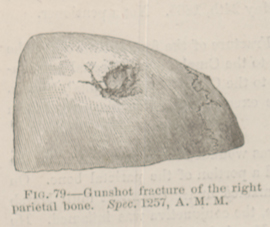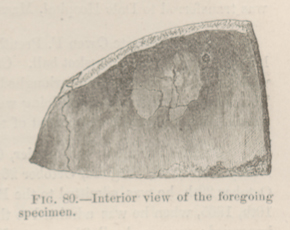Title: V——, George
Source text: Surgeon General Joseph K. Barnes, United States Army, The Medical and Surgical History of the War of the Rebellion. (1861–65.), Part 1, Volume 2 (Washington, D.C.: Government Printing Office, 1870), 167-168.
Civil War Washington ID: med.d1e11786
TEI/XML: med.d1e11786.xml
CASE.—Private George V——, Co. C, 84th New York Volunteers, was wounded at Chancellorsville, May 3d, 1863, and admitted into Carver Hospital at Washington, D. C., on May 7th, 1863. His injury was supposed to be a simple scalp wound from a musket ball. It was situated over the right parietal protuberance, and on admission was granulating kindly. Ten days subsequently the patient, after a walk out of doors and sitting in the hot sun, had headache and nausea, and the wound gaped and its edges ulcerated. On May 17th there was headache, and his stomach would not retain food. On May 18th the probe detected denuded bone; but no fracture was discovered. There were no febrile or cerebral symptoms. On May 20th a depression of the outer table of the skull was detected. At night there was delirium, and the following day the pulse became feeble and irregular, the stomach irritable, the tongue heavily furred. On this and the following nights the patient had two and a half grains of opium at bedtime. His diet was low, though chicken broth and custard were allowed. On this day there was a decided icteric hue over the whole surface. The patient died on May 22d, 1863, being conscious and rational to the last. At the autopsy, extensive inflammation of the dura mater was observed, and softening of the middle lobe of the right cerebral hemisphere. The notes of the case were drawn up by Assistant Surgeon E. F. Bates, U. S. V., and were contributed with the specimen, which is represented in the wood-cuts above, (FIG. 79 and FIG. 80,) by Surgeon O. A. Judson, U. S. V. The fracture of the external table is half an inch in diameter, and is depressed two lines. The inner table is fractured to the diameter of an inch, and depressed in the centre one line. A few hairs are wedged in among the fragments. The surrounding bone is porous and cribriform.

